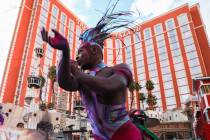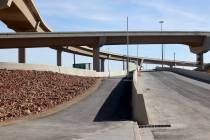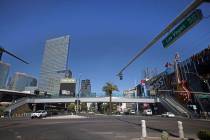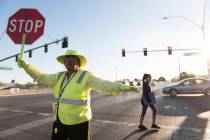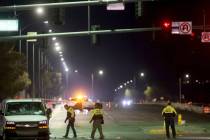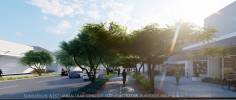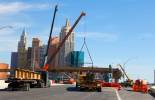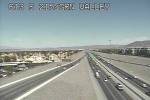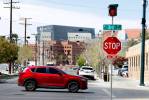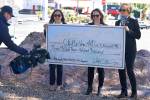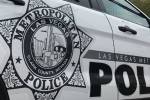Revamped parkway still leaves questions
For more than a year, Green Valley Parkway was torn up, put back together again and then blanketed by a smooth layer of asphalt. This is not news to anybody who travels the arterial daily. As the road was reassembled and finished, some additional concerns arose. We'll lead off with those potential problem areas.
Several readers in the Green Valley area have asked: When you are traveling north on Green Valley Parkway and approach the Horizon Ridge Parkway intersection, you will see that the lanes on the opposite side of the intersection are offset to the left by 3 to 4 feet. This can cause some confusion as you are not sure which lane to enter as you cross the intersection. Plus there are no markers to guide you through the offset. Can you look into this lane offset?
Henderson officials say that the lane offset from one side of the intersection to the other is more than they would like to see. The city will adjust the lane markings so that the lanes align properly across the intersection. They are looking to have the work finished in early January.
And another Green Valley resident wonders: Why is the bicycle lane on Green Valley Parkway between Horizon Ridge and the Las Vegas Beltway away from the curb and next to the automobile lane? Wouldn't it be safer away from the auto lane and next to the curb? Just curious.
Green Valley Parkway is unusual in that it is not wide enough to accommodate three vehicular travel lanes and a standard 4-foot-wide bicycle lane. At the same time, it is wider than the requirements for the existing lanes and a bike path. According to Henderson spokeswoman Kathleen Richards, if the bike lane was placed next to the curb, the extra road space might give motorists the idea that there is an additional travel lane.
"Placing the bike lane away from the curb allows for an emergency breakdown lane, creates standard width travel lanes, and a wider bike lane," Richards said. "The breakdown lane is also available to bicyclists that want to keep the maximum buffer between themselves and motorized traffic."
Stan airs his concerns: At Pavilion Center Drive and Greenmoor Lane there is a four-way stop sign next to Desert Spring Methodist Church, Veterans Memorial Center, and Palo Verde High School. The stop signs seem to be too small for the area and we have seen cars actually run through the crossroads here. This scares me because there are so many children walking through this area. Can't these stop signs be changed to ones with flashing lights around the sign to mark it better?
It turns out that stop signs are sort of a complex issue. The minimum height for stop signs along Pavilion Center are 36 inches and the sign currently at the intersection of Greenmoor is 48 inches. On Greenmoor, the minimum height for a sign is 30 inches, which is exactly how tall those are. Flashing stop signs, according to the city of Las Vegas, are reserved for intersections where the approaching roads have higher speed limits. Engineers determine whether they are necessary by road alignments or whether there have been a significant number of wrecks what warrant the extra attention-getting flashers.
With all that said, here's the good news: The city is planning to install a traffic signal at Pavilion Center and Greenmoor next year. It is aiming for May.
Norm is turned off: I drive from Las Vegas to Indian Springs and continue to be impressed with the extent of the upgrades to this stretch of highway, except for one glaring omission. The Department of Transportation has widened the road bed and added several much needed turnoff lanes except for one spot. The people who work at the High Desert State Prison have to make a left turn off U.S. Highway 95, and for some reason, this is the only place they neglected to improve the turnoff lane. They added and improved many turnoff lanes and I'm trying to find some logic in why they skipped the turnoff to the prison.
Norm, your commute should improve by the end of next year. Transportation officials are scheduled to improve this stretch in the spring, when temperatures improve and the paving can be completed.
Greg thinks electric cars should pay: I have a question about electric cars here in Nevada. We all pay federal, state, county and local taxes when we fill up our gas or diesel burning vehicles to help the upkeep of roads. Is there anything in place for the electric cars to pay their share of road upkeep?
Not at this time Greg, and that is a great concern to transportation officials who have watched gas tax revenues dwindle as the popularity of electric and hybrid vehicles has grown.
The more environmentally friendly vehicles may use less fuel, but they still cause the same wear and tear on the roads as traditional vehicles. Fuel taxes go toward the construction and maintenance of the roads.
The Nevada Department of Transportation is studying a Vehicle Miles Traveled program, which would attach a fee for each mile driven. If the entire nation hopped on board, the fee eventually would replace fuel taxes. The department is considering introducing pilot vehicles to test it.
If you have a question, tip or tirade, call Adrienne Packer at (702) 387-2904, or send an e-mail to roadwarrior@reviewjournal.com. Include your phone number.
Expect lane restrictions today at the intersection of Desert Inn Road and Lamb Boulevard as crews repair a large water main. Restrictions also will be in place on Desert Inn between Ferndale Street and Nellis Boulevard because of standing water.
For the next eight months, traffic on Russell Road at Interstate 15 will be routed to the north side of the bridge with two lanes in each direction.
Hinson Street between Charleston and Oakey boulevards will be closed to through traffic until Jan. 2 for the installation of storm drains. The intersection of Mountain View Boulevard and Hinson also will be closed.
Northbound Rancho Drive to Ann Road near Sante Fe Station will be closed to traffic at Rainbow Boulevard from Monday through Dec. 22 for ramp realignment.
For the next week or so, expect lane restrictions on Rampart Boulevard at the Hillpointe Road intersection. Rampart will be reduced from three to two travel lanes in each direction.
Las Vegas Review-Journal










